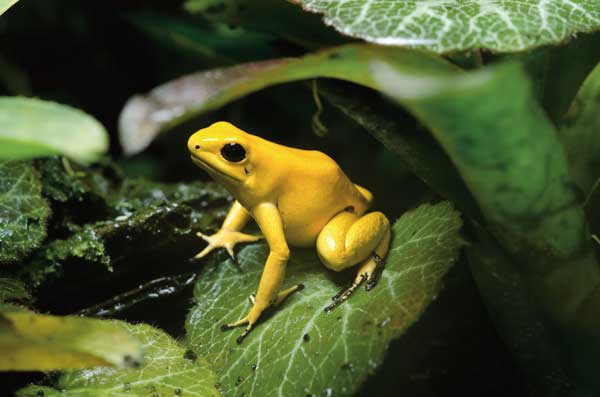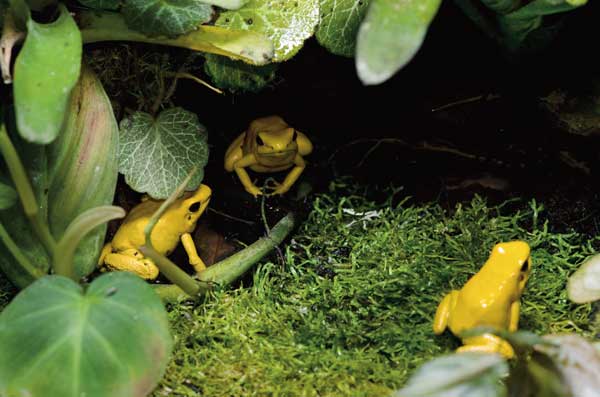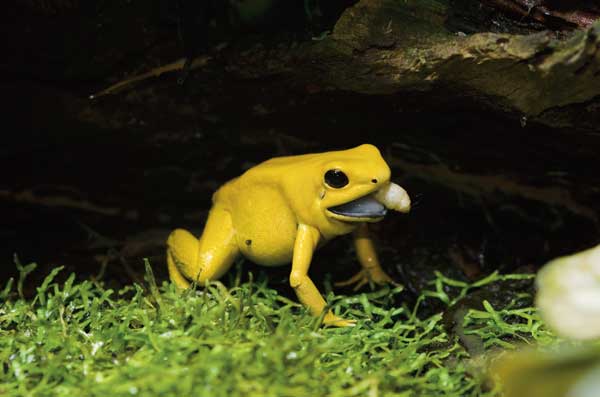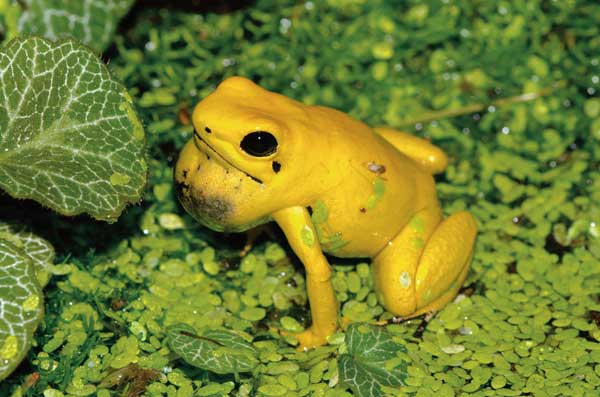Habitat, feeding and breeding tips for Phyllobates terribilis.
Dart frogs are probably the most eye-catching animals in the reptile and amphibian hobby. Virtually every zoo has at least one dart frog exhibit, usually containing Dendrobates auratus or D. tinctorius. These are among the most colorful kinds of dart frog available in captivity, and they are also among the largest. Truth be told, they are not real poison dart frogs. The only dendrobatid frogs used to poison the darts of the indigenous tribes of northwestern South America are from the genus Phyllobates. Of the dart frog family Dendrobatidae, only the members of this genus possess the dangerous levels of toxin necessary to kill a man, and only one could kill a man many times over: the golden dart frog (Phyllobates terribilis).
This deadly and beautiful creature inhabits the lowland rain forest near the Pacific coast of Colombia. The native Embera tribe of the Cauca region use the secretions of this frog on their blowgun darts. This species possesses so much toxin that merely wiping a dart along the back of a heat-stressed frog will yield enough toxin to bring down a large mammal.
Fortunately for hobbyists, captive-bred specimens are devoid of the most dangerous toxins, rendering them safe to keep in a terrarium. This is because the frogs obtain and concentrate their deadly poisons from the food that they eat in the wild. It is not certain as to what the food item is that helps them produce the poison. It may be from beetles. This is not to say that captive-bred specimens are without toxins, but those that the frog can produce on its own are unlikely to threaten the life of a healthy adult human, even if you were to put the frog in your mouth. That being said, like all amphibians, these frogs should not be handled unless absolutely necessary. Amphibians have delicate, permeable skin that makes them vulnerable to pollutants and to the secretions and soaps on human skin. Handling should be gentle and done only with pre-rinsed hands. After handling, thoroughly wash your hands with soap and water.

Photo by John Clare
Fortunately for hobbyists, captive-bred golden dart frogs are devoid of the most dangerous toxins found in wild frogs, rendering them safe to keep in the terrarium.
Powerful Predators
The golden dart frog, often simply referred to as “terribilis,” can grow to a size of 2 inches. On paper, this puts it on par with the larger races of Dendrobates tinctorius, such as the blue dart frog, often just called “azureus.” But size does not depend on length alone. Terribilis are much broader and more powerfully built than their cousins. They are capable of tackling much larger prey, and they will even ignore small prey items that would attract a large D. tinctorius.
Aside from a slimmer build and marginally smaller size, males are often hard to distinguish from females. These frogs reach maturity by about 18 months of age. Mature males have slits inside the throat, at least one of which must open in order for the frog to make a significant calling sound when inflating the vocal sac. This only occurs near maturity, and a mature male terribilis is one of the loudest dart frog species. The call sounds like a rapidly repeated clucking sound. There are reports of females calling in response to males, and I have occasionally heard females in captivity make a squawking sound after a male finishes his long call.
Colorful Captives
Terribilis can be acquired in three morphs. The mint morph is a striking metallic mint green and is generally slightly larger than the other morphs. These frogs blend in well with green foliage; if you want them at their most visually striking, keep that in mind when choosing plants and substrate for your terrarium. For example, a carpet of dead leaves would make a more contrasting display terrarium for the mint morph than would a carpet of moss or Riccia.
The other two morphs are known as “yellow” and “orange.” They are close enough in coloration that it is often difficult to positively identify one unless the two can be compared. The general school of thought within the dart frog hobby is to keep morphs of the same species separate to prevent interbreeding of frogs that do not occur together in the wild. Likewise, please do not keep different Phyllobates species together, because they are quite capable of interbreeding. Unlike some of their cousins, Phyllobates are gregarious and do well in groups of more than two frogs. This can make them more appealing to first-time dart frog keepers who are put off by only being able to keep a single pair of D. tinctorius in the terrarium.

Photo by John Clare
Unlike some other dart frog species, Phyllobates terribilis do quite well when kept in groups of more than two frogs.
Acquisition
Golden dart frogs are only available as captive-bred animals. The wild frogs are protected from export, and all of the specimens found in captivity in the United States and Europe are descended from legally or illegally exported frogs. British Colombia and Alberta in Canada have banned the possession of this species on the misinformed basis that captive specimens are toxic. Elsewhere in North America, these frogs are readily available in the dart frog hobby and from many dart frog vendors.
The mint morph is the most commonly available and usually the least expensive. The orange and yellow morphs are a little less common and consequently they are a little more expensive. You shouldn’t have to pay more than $90 for a juvenile frog of any type. When choosing a frog in person, look for one with a well-fed belly, bright eyes, secretion-free skin and a bold nature. If possible, ask the vendor to feed the frog in front of you. A healthy terribilis will be more concerned with chasing food than with you watching.
Young terribilis are a dark brown or black frog, with stripes of adult color running from either side of the head along the upper edges of the back. They also possess spotted or patchy legs. Juveniles do not develop the solid coloration of the adults until they are a few months old.
Care and Housing
These large, bold frogs are very terrestrial, and while they do climb on occasion, they are most commonly seen on the terrarium floor, perhaps more so than any other dart frog. With that in mind, it is important to choose a terrarium that provides a large amount of floor space per frog. For an adult terribilis, I consider 100 square inches to be the absolute minimum per frog. This would allow you to keep three adults comfortably in a 20-gallon long aquarium (30 inches long by 12 inches wide by 12 inches tall). I maintain five adults in a 40-gallon breeder tank, which measures 36 inches long and 18 inches wide. Juveniles can be kept in much smaller accommodations while they grow. I have had good success keeping five or six large juveniles in a 5-gallon terrarium, provided it is well-maintained and that it is only a temporary arrangement.
An all-glass aquarium makes a relatively cheap terrarium for these frogs. Custom-made acrylic terrariums can be purchased from specialist vendors, and the big-name terrariums sold commonly at reptile shows can be readily converted into dart-frog-friendly terrariums.
A secure-fitting lid and the ability to maintain humidity are necessary traits for any proper golden dart frog terrarium. Humidity can be maintained with daily misting using a hand mister. Distilled water is ideal for this purpose because it will leave virtually no mineral deposits on the glass, which might obscure your view of the frogs. If you have more than one terrarium, or you want to construct a striking display terrarium, consider a commercial misting system. They are not cheap, but it’s one less chore to perform, and having one ensures a relatively constant level of humidity, whether you’re around or not.
My first step for a new terrarium, particularly when it’s meant as a display terrarium, is to make a drawing of how I want to landscape it. Typically, I begin by constructing a background. The easiest approach is to use aquarium silicone to glue tree fern fiber panels to the back wall. I fill in the gaps with terrarium soil (more on substrate later). These panels are excellent for planting bromeliads and climbing plants, and mosses usually begin to grow on the panels in a few months. You can now buy rectangular corkwood panels designed specifically as terrarium backgrounds. They can be attached using aquarium silicone. Be sure to seal any holes and gaps that might allow a frog to enter and become trapped. A third option for background material is to spray a layer of expanding polyurethane foam on the aquarium wall. When cured, this is then covered with silicone and then substrate material, such as coconut fiber, is pressed into the still-wet silicone. A fourth option is to mix a clay recipe that can be pasted onto the aquarium glass.
After the background has been set up and cured, I construct the drainage layer. This is where excess moisture will end up, away from the substrate, which can rot and become anaerobic if waterlogged. In large terrariums, I like to include a pond area. This is readily accomplished by leaving a space in the drainage layer in a corner of the terrarium. The drainage layer itself should consist of at least 2 inches of a low-density material, such as hydroton/LECA or the plastic egg crate sold as a diffuser for fluorescent lighting. There are commercial alternatives available from some dart frog vendors. If money is a factor, aquarium gravel can be used, but this can be extremely weighty, an important property to minimize if you think you might ever have to move the terrarium.
The drainage layer is covered with a layer of fine fiberglass mesh, such as window screen, in order to prevent particles of substrate from entering the drainage layer. The substrate itself should be at least 1 inch thick. Slopes and valleys can be constructed by varying the substrate depth. Substrate choices should be free of artificial additives and perlite. Good options include aquatic soil products, ABG mix developed by Amphibian Ark’s Ron Gagliardo, and coconut husk mixed with coconut fiber. In recent years, many hobbyists have made their own substrate mixture with a large component of clay, as this seems to be closer to the natural substrate of the rain forest.
I like to cover the substrate with leaves that last a long time under humid conditions. Suitable species include live oak, magnolia (southern is better), sea grape, pin oak and Indian almond. Thicker leaves generally last longer; you can use the thinner leaves of more northerly tree species, just don’t expect them to last long.

Photo by John Clare
These frogs are capable of tackling larger prey than other dart frogs, such as Dendrobates tinctorius. Waxworms should be offered only as an occasional treat.
Landscaping
Landscaping is up to you. Large pieces of driftwood can make striking centerpieces, as can large pieces of cork bark made to look like tree trunks. These offer good sites for bromeliads and other epiphytic plants. Be sure to use a wood that can stand up to humid conditions without molding frequently or rotting away. Good choices include ghostwood, mopani, Malaysian driftwood and manzanita. I prefer to avoid the grapewood commonly sold for reptile terrariums because I find that it never really ceases to mold.
Most terrestrial dart frogs lay their eggs in bowers. It’s often wise to include these in your landscaping design in advance. The favorite choice of most dart frogs is a half-coconut shell with a plastic Petri dish underneath. You can also choose pieces of wood based on the hides or overhangs they provide. If you are using a foam-based background, you can carve caves and shelves into it to serve the same purpose, prior to covering the foam with silicone and coconut fiber.
At this point, your thoughts should turn to planting. Most terrarium plants are at least partially epiphytic (they get their nutrients from the air). This includes the “tank” bromeliads, such as Neoregelia and the Tillandsias. When choosing bromeliads, select those that are small enough for the terrarium. Many of the bromeliads available at hardware stores and garden centers are youngsters of large species, or they have been forced to bloom at a smaller size than their true growth potential. Consult a dart frog vendor for specific recommendations, but a few suitably sized varieties include the following Neoregelia: dartanion, ampulacea red, June night, ritzy red, ariel, shamrock, fireball, Zoe and wee Willy.
Most other tropical plants can be planted in the substrate layer. Popular choices include tropical begonias, aroids (Syngonium, Philodendron and Pothos), Ficus, Peperomia, Hoya, tropical mosses and even aquatic plants, such as Java moss (Vesicularia dubyana) and Riccia fluitans. If kept moist and given plenty of light, Riccia can form a beautiful green carpet in the terrarium, and there’s nothing as striking as a bright golden yellow terribilis standing on a field of Riccia. Many of the plants mentioned earlier are available at the hardware store as shade-loving house plants. Be sure to rinse these plants thoroughly to remove any pesticide residue before placing them in the terrarium.
If you wish to grow plants successfully, an artificial lighting solution will be required. The fluorescent lighting fixtures sold for aquariums are often the most convenient solution. Be sure to choose the freshwater variant because these bulbs will be in the proper color temperature range for tropical plant growth, namely 5,000 to 10,000 Kelvin. I like the color and results from bulbs that are 6,500 or 6,700 K.
Terribilis are one of the more cold-tolerant and heat-intolerant dart frog species. A daytime range of 65 to 75 degrees Fahrenheit is appropriate, followed by a slight drop at night to as low as 60 degrees. This species does not tolerate temperatures in excess of 80 degrees. If you cannot maintain temperatures below this maximum, consider acquiring an air conditioner or keeping the frogs in a basement; it is generally easier to heat a terrarium than to keep it cool. My favorite heating solution, particularly for a large terrarium, is a heating cable.
Traditionally, these are sold for growing plants, but manufacturers are beginning to market them to terrarium keepers. Be sure to get a waterproof model and an appropriate thermostat. These systems provide a gentle, near-constant heat. If you have a large drainage area that always contains more than an inch of water, you might consider an aquarium heater. These will heat the water directly, but this will also pass on some heat to the air and substrate.
Terrarium maintenance each month should be minimal. Wipe the glass with paper towel dipped in distilled water. Trim plants as they start to get out of control and obscure your view. Fluorescent bulbs lose intensity with age and are best replaced about once per year. You should almost never have to change the substrate. Most dart frog terrariums that are set up after advanced planning can go at least three years before they need to be re-constructed.
Feeding
Keeping dart frogs can be a challenge for the first-time keeper. Thankfully, feeding them is a straightforward matter. Virtually all dart frog hobbyists culture their own fruit flies. Fruit fly culturing supplies are available at reptile shows and from online vendors. Cultured fruit flies are flightless or wingless mutations of the species Drosophila melanogaster (a small species) and D. hydei (a large species). Drosophila hydei are the staple of choice for larger dart frogs such as terribilis. In fact, adult terribilis will often ignore D. melanogaster due to its small size.
Fruit flies in and of themselves are not a complete food for dart frogs. They require augmentation using commercial vitamin and mineral supplements. I dust my fruit flies at every feeding, rotating through three well-known supplements, two of which are different brands of general vitamin and mineral supplement, and the third is a calcium supplement with vitamin D3.
Adult terribilis should be fed every two to three days with at least 20 D. hydei per frog. Youngsters and froglets should be fed on a daily schedule. In my experience, terribilis froglets can take the larger fruit flies as soon as the frogs begin eating after metamorphosis. Adult terribilis that have been well-fed can safely go a week without feeding. This is not possible for youngsters, so if you must go on vacation, make sure you have trained a friend or neighbor in how to feed your frogs.
Much of the necessity for supplements is due to a lack of food variety. However, often this can’t be helped when it comes to sourcing a small and reliable food source for our dart frogs. Captive-cultured crickets are a handy alternative that can add some variety to the diet of terribilis. Indeed, adult frogs of this species are capable of tackling near-full-grown crickets with ease. Youngsters relish pinhead/hatchling crickets. Some keepers mistakenly believe that crickets and other large prey items are essential to keep terribilis successfully. This is not the case. However, there is anecdotal evidence that food variety may stimulate breeding behavior in this frog, and a varied diet cannot be a bad thing.
Terribilis are capable of taking large food items, and they enjoy treat foods such as waxworms and firebrats. An adult terribilis can easily swallow several mature waxworms. Waxworms are a high-fat food and should only be fed on rare occasions. I like to give my adults a feeding of waxworms once or twice each month.

Photo by John Clare
Mature male golden dart frogs have slits inside the throat, at least one of which must open in order for the frog to make a significant calling sound when inflating the vocal sac.
Breeding
If both sexes are present, healthy mature terribilis will usually begin to breed by the age of 18 months. Some do not breed successfully for more than two years. No distinct breeding stimulus should be necessary because these frogs are from tropical latitudes and breed naturally throughout much of the year.
The time taken to reach maturity makes them one of the longer-term investments for the dart frog breeder. Eggs are laid in a bower, such as in a Petri dish under a coconut hut, or on the leaf of a plant in the aroid family. Clutches are large, sometimes numbering in the twenties or even into the thirties. The eggs hatch in about 14 days. If left in the terrarium, the male will carry the hatchlings individually, or in tadpole packs on his back, to the nearest water source. An in-terrarium pond is great for this purpose. Generally, only about 50 percent of the eggs survive to hatching.
Tadpoles are gregarious and do not secrete large amounts of growth-inhibiting hormone as Dendrobates tinctorius tadpoles do. They should be kept at similar temperatures to the adults during the daytime. If raising the tadpoles outside the terrarium, be sure to treat tap water with an aquarium dechlorinator, and also administer a tannin-rich additive, such as Blackwater Extract, to mimic natural water conditions.
A good fish food pellet should be the staple diet of tadpoles. I like to alternate between a fish food pellet containing some vegetable matter as well as the normal fishmeal component, and a pellet intended for more carnivorous fish.
Terribilis tadpoles metamorphose in as little as 50 to 60 days. Be sure to provide an easy escape from the water so that the froglets do not drown. They will not feed while they are resorbing their tails and for a day or two afterward. Given that the froglets can usually take Drosophila hydei from the start, terribilis are probably the easiest of all dart frogs to raise.
Hardy and Bold
While the golden dart frog may be the most infamous of amphibians, it is perhaps the boldest and hardiest dart frog in captivity. The striking coloration and ease of feeding should put this species at the top of the list for the first-time dart frogger, as well as the more experienced enthusiast.
John Clare, Ph.D., is the founder of caudata.org, the longest-running amphibian community on the Internet. He is also the founder of frogforum.net.


